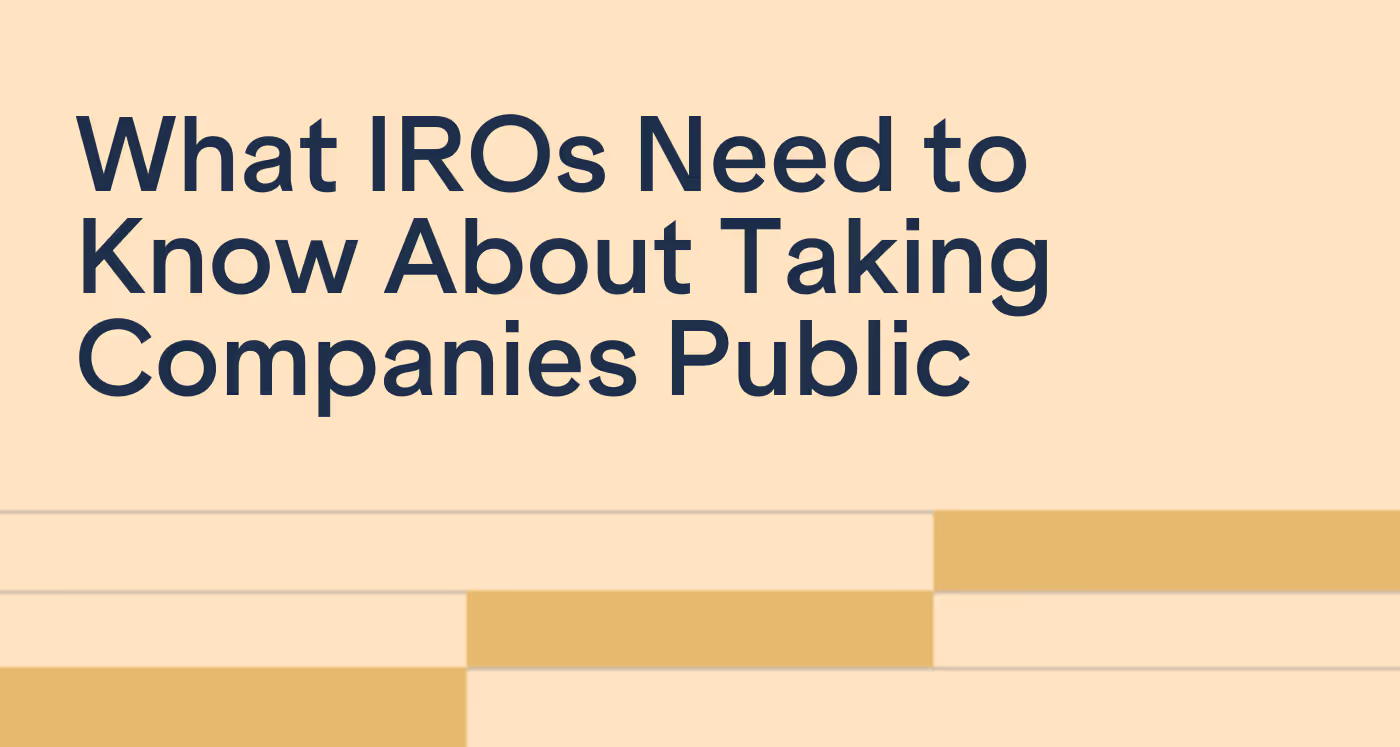
How to Build Effective Investor Targeting and Outreach Strategies for Small-Mid-Cap Companies
Learn how seasoned IR veterans are executing targeting strategies for small-mid-cap companies.

The IR function is both an art and a science as it combines finance, analytics, marketing, and communications into one strategy. So how can IROs and others in the industry create a program that gives you the best of all worlds?
We recently sat down with Fabiane Goldstein—Senior Director of Investor Relations at Grayling—to get her expert perspective on the overlap between IR and PR and what IROs can do to build their investor brand.
Continue reading for insights on:
Building an investor brand and developing long-term relationships with shareholders requires a well-defined strategy, effective and transparent communication, and a commitment from the board of directors and executive leadership.
However, the success and growth of an investor brand doesn’t come without its own set of unique challenges. Both IR and PR professionals will likely face similar challenges in the early stages of building a company brand, including:
Building an investor and company brand requires establishing credibility and trust among potential investors and your desired audience. It can be particularly difficult to do so if your business is new in the industry or the company focus hasn’t been on building a brand. IR professionals must continuously demonstrate a track record of successful investment and business decisions to gain trust—and recognition—in their industry.
No matter which sector, most industries are becoming increasingly saturated, with numerous businesses vying for the attention of investors, the public, and other important stakeholders. Standing out from the crowd and differentiating your public brand can be challenging. IROs must find unique ways of communicating their brand and value proposition to potential shareholders.
Whether it’s building and expanding your network or managing your reputation in the industry, having a solid relationship with your public audience is critical for any professional in IR. Developing and nurturing these relationships over time is essential for building a strong investor brand and requires proactive outreach and engagement. Remember that the PR and IR functions are closely linked, and you should “be building strong relationships with the media in both the good and bad times,” explains Goldstein.
“Building these relationships with journalists and other members of the public—not just the CFO or CEO of your own company—is an important tool for IROs. Your relationship with the public and the media is a two-way street. Sometimes, you’ll have to be a reliable source of information, and in other cases, they’ll be there for you.”
In recent years, social media has become integral to any IR (or PR) strategy. offers new opportunities to connect and engage with current shareholders, potential investors, and the wider general public across various channels.
IROs looking to level up their strategy while simultaneously building their investor brand should consider the vast benefits of social media, such as:
IROS must understand social media's impact when delivering a reputable and compelling story for retail investors, as it’s considered one of the best ways to communicate with that audience. From Twitter to Reddit, companies need to be active on social platforms to connect with their audience and understand the discussions that are taking place about their stock.
IR teams and their respective organizations also need to remember that while social media is viewed more often as a retail-focused strategy, there is also an opportunity to connect with institutional investors. While perhaps less prominent or vocal, institutional investors are increasingly in the background of social media, keeping up with their industry and its accompanying trends. Don’t miss out on a unique opportunity to connect with them.
Collaboration between IR and communication functions within an organization is essential to maintaining a positive corporate image, growing investor confidence, effectively communicating strategic goals, and navigating any possible challenges or crises.
In Goldstein’s experience, “the most successful companies are the ones that actively make an effort to integrate both their investor relations and communications functions.” It's common for IR teams to be small, which makes it difficult for companies to keep up with everything occurring on social media. At the same time, communications functions often don’t have IR or company stakeholders at the top of their minds when preparing any public messaging. Goldstein recommends IR professionals to “be a partner of the communications team.”
Viewing and treating your communications team as a partner to the IR function and ensuring that they’re engaged in the strategy is the “best way for them to understand that investors will also see everything that they produce,” explains Goldstein. “They need to truly know the impact their messaging and communications strategies can have on investors and potential shareholders.”
There is no exact science behind measuring the ROI of combined IR and PR functions. In fact, it’s important to remember that brand-building efforts are more often seen as a marathon versus a sprint.
However, this doesn’t mean there aren’t a few ways to keep an eye on the success of your combined strategies:
Whether it's improving brand reputation, increasing shareholder value, or enhancing audience engagement, ensure goals are set within the teams. These will provide a foundation for measuring ROI.
While communications teams often work with less quantifiable metrics, there are some numerical values you can track to measure the effectiveness of your efforts, including:
Once you’ve determined the metrics you plan to measure, you can begin to monitor the data over a predetermined period of time. Analyze the information regularly to identify trends or patterns and avoid surprises.
Remember to evaluate qualitative factors regarding the success of your investor and public relations strategies. While quantitative metrics provide valuable insights, you must assess the overall impact of integrated IR and PR efforts on the organization's reputation, relationships with stakeholders, and market perception. Qualitative feedback from investors, analysts, and media can help gauge the success of your integrated approach.
Measuring ROI is an ongoing process that takes time to show significant results. By continuing to monitor your integrated efforts, you’ll be better equipped to understand its impact and optimize accordingly.
By partnering with the communications team and leveraging existing company content, IROs can develop an investor marketing strategy that effectively communicates with investors and strengthens their relationship with the company. This strategy can also help ensure consistency within your messaging while enhancing engagement and saving time and costs.
For Goldstein, finding opportunities to repurpose existing content in her IR strategy is essential. This includes reformatting annual reports or presentations into shorter, more digestible pieces for social media posts or blog articles. She also recommends organizing all your company announcements over the past four weeks into a monthly newsletter to send directly to your audience’s inbox. “This ensures maximum visibility of your messaging,” she explains.
Goldstein also recommends tailoring your content for different communication outlets. Different channels will require different formats and tones, so it’s crucial to customize your content to suit each channel’s requirements.
“It’s all about testing different channels and seeing what works best for your goals and strategy.”
.avif)
Working with your organization’s communications team will help you build an impactful IR strategy. To better maintain and grow relationships with the investment community, an IR CRM is a bonus. By implementing an investor relationship management solution, you can track all your interactions and maximize the impact of your communications efforts by measuring which messages resonate with your audience.
An IR CRM also enables IR teams to identify key investors for engagement. Once you have an understanding of who your targets are, you can personalize your messaging and choose effective channels to ensure your media strategy reaches the right audience.
To learn more practical advice on integrating the IR and PR functions, listen to Fabiane Goldstein’s full episode on Winning IR.
Learn why IR professional prefer Irwin's best-in-class IR CRM

Learn how seasoned IR veterans are executing targeting strategies for small-mid-cap companies.

Elizabeth Librizzi breaks down the secrets of buy-side corporate access to help investor relations professionals utilize buy-side firms.

What IROs Need to Know About Taking Companies Public: Insights from award winning investor relations thought leader Catherine Buan.